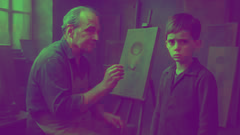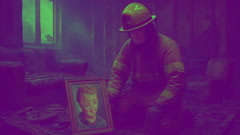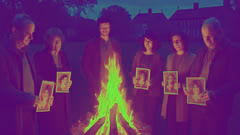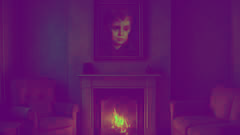Introduction
Few modern legends have gripped the United Kingdom’s collective imagination quite like the tale of the Crying Boy painting. It’s a story whispered in hushed tones over tea, debated in online forums, and retold by generations who swear they’ve glimpsed the haunted eyes themselves. To some, it’s merely an old print—one of thousands churned out in postwar Europe, its mass-produced canvas gracing council flats and semi-detached houses from London’s East End to the windswept terraces of Yorkshire. To others, it’s a harbinger of disaster: a cursed artifact lurking behind floral wallpaper, its tear-stained child’s gaze blamed for blazes and ruin. Over the years, newspaper headlines have fanned the flames of the legend. Firefighters share stories of homes consumed by sudden infernos, where everything lay in ashes except for a single painting—untouched, as if protected by some cruel force. Skeptics offer explanations, citing cheap manufacturing and urban myths, but those who’ve witnessed the painting’s unyielding stare often find little comfort in logic. For the families who lost homes and memories, for collectors who dare hang the painting in defiance, and for the curious who seek to unravel its mystery, the Crying Boy is more than paint on paper. It’s a modern British ghost story—a blend of art, tragedy, and the persistent chill of the unexplained.
Origins: From Studio to Sitting Room
The legend of the Crying Boy didn’t begin in the ashes of a burned-out home, but in the bustling studios of 1950s Spain. The original painting—one among many—was the work of a little-known Italian artist who signed his pieces “Bragolin.” The painter, whose real name was Bruno Amadio, specialized in portraits of weeping children: big eyes, trembling lips, glistening cheeks. His subjects were meant to evoke empathy and melancholy, perhaps even offer a warning against neglect. Yet, as the images spread across Europe, their mood darkened into something far more ominous.

By the 1960s and 70s, British importers saw an opportunity. Cheap prints of the Crying Boy, and its companion paintings—Crying Girl, Crying Baby—began to appear in high street shops and mail-order catalogues. The prints were affordable, mass-produced, and found their way into thousands of homes. There was an odd comfort to the sad-eyed children, a sense that their sadness might somehow absorb a household’s own misfortune. For many working-class families, the paintings were as common as lace curtains or flying ducks on the wall.
But while the images multiplied in living rooms, the painter himself faded into obscurity. Bruno Amadio remained a mystery: some said he’d painted the children after witnessing war’s devastation; others whispered that his models were orphans who met tragic ends. The uncertainty only deepened the painting’s aura. No one could quite pin down its origins, yet nearly everyone knew someone who had one hanging somewhere in their home.
Decades passed. Children grew up, moved out, and left the paintings behind, gathering dust in grandparents’ parlors or thrift shops. For a while, it seemed the Crying Boy was destined to be nothing more than a kitschy relic of postwar décor—until fate, or something darker, intervened.
The Firestarter Years: Newspaper Panic and Fire Brigade Fears
The transformation from sentimental print to cursed object began suddenly. In 1985, the British tabloid The Sun ran a front-page story with a headline that would ripple through the country: “Blazing Curse of the Crying Boy!” The article reported a string of mysterious fires in Yorkshire and beyond, all with a common denominator—a copy of the Crying Boy painting hanging on the wall. Most chilling of all, the reports claimed that while everything else was reduced to blackened debris, the painting survived untouched.

Soon, the phone lines at local fire stations buzzed with anxious callers. Families recounted harrowing tales of nighttime blazes: the terrifying crackle, the choking smoke, and afterward, the eerie discovery of the painting face-up amid the ashes. Some swore they’d tried to burn the painting themselves, only to watch it emerge from the flames as if protected by an unseen shield. Others, desperate to rid themselves of the curse, dumped their copies at rubbish tips or set them alight in back gardens—yet stories persisted that the image would reappear in the home, or that disaster struck soon after its removal.
The tabloids couldn’t get enough. Over the following months, stories multiplied. One report told of a family who lost three homes to fire, each time after hanging a different version of the Crying Boy. An elderly couple in Rotherham claimed their flat was gutted within days of receiving the print as a gift. A Liverpool woman described how she tried to destroy the painting only to find her kitchen ablaze the next day. In the north, firemen began to swap stories about the “curse” in the break room. Some even refused to enter homes displaying the painting, muttering that they’d seen too many survivors with only that sorrowful child intact amid the wreckage.
Amid the panic, experts offered more mundane explanations. Chemists pointed out that the print’s varnish was highly fire-retardant, making it less likely to burn than flammable wallpaper or furniture. But for those whose lives had been upended, scientific logic offered little solace. The legend had caught fire in the public’s imagination, and soon the painting was less a home decoration than an omen—a symbol of fate’s cruel hand, hanging in the corner of every unlucky living room.
The Curse Spreads: Families, Fear, and Defiance
By the late 1980s, fear had swept through communities across Britain. Council estate tenants passed warnings from flat to flat: get rid of the painting or risk disaster. Thrift shops and charity bins overflowed with discarded prints, their tear-stained faces peering out from behind faded romance novels and chipped crockery. Some towns even organized mass burnings, neighbors gathering in local parks to consign stacks of Crying Boy prints to communal bonfires. Yet, rumors swirled that the curse lingered on—if anything, intensified by efforts to destroy it.

Within families, arguments flared. Elderly relatives clung to their paintings, insisting they brought no harm, while younger generations demanded their removal. The legend took on new twists as tales grew more elaborate: a mother’s dreams haunted by the boy’s silent wails, a schoolboy convinced his pet’s sudden illness was linked to the painting, a teenage girl claiming the image moved when she wasn’t looking. In pubs and bus stops, people traded stories: some tragic, some comic, all laced with a nervous fascination.
At the same time, a counter-movement emerged. A handful of skeptics—art collectors, journalists, university students—began to seek out the painting on purpose. They hung it proudly in their own homes, inviting friends to witness their defiance. Some even taunted the curse, daring it to do its worst. A few tried to organize exhibitions, placing dozens of prints together in one room, hoping to neutralize the superstition through sheer audacity. But these acts rarely shook the painting’s reputation. Instead, every fire reported near one of their homes seemed only to reinforce the legend: even if coincidence, it was hard to dismiss once fear had set in.
As years passed and news coverage faded, the painting’s fame lingered on the fringes of British culture. The Crying Boy became a fixture in urban folklore, alongside tales of Black Shuck and phantom hitchhikers. In some towns, finding an old copy at a boot sale still prompted nervous laughter or sidelong glances. The curse had woven itself into the fabric of everyday life, impossible to dispel with facts or bravado alone.
Conclusion
Even now, decades after its first public condemnation, the legend of the Crying Boy painting refuses to fade away. In flea markets and antique shops across the UK, you can still find the sorrowful face peering from behind stacks of bric-a-brac. Some buyers purchase it as a conversation piece; others as a joke or to test fate. But many will admit—if only in a whisper—that they’d never hang it on their own wall. There’s an uneasy power in stories like these: a reminder that even in the age of reason, superstition lingers where emotion runs deep. The Crying Boy’s curse is less about malevolent spirits than about the ways fear travels from neighbor to neighbor, generation to generation. It lives in the telling—a lesson in how ordinary objects can take on extraordinary meaning, and how tragedy sometimes leaves its mark not just on homes and hearts, but on culture itself. The painting’s eyes still haunt those who pause before its frame, blurring the line between the possible and the impossible, between what we believe and what we fear.













